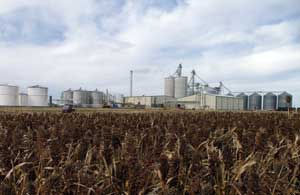March 2010
 View Full Print Edition
View Full Print EditionBusiness Briefs

Business and People
By BBI Staff
Columns

Fix the Fence, Tackle the Core Problem
By Mike Bryan

The Ethanol Decade Redux
By Bob Dinneen

Federal Support for Biofuels Intensifies
By Rona Johnson

I'm No Protectionist, but...
By Ron Kotrba

Starting Up in the Worst of Times
By Todd R. G. Hill
Featured

Farmers Should Enter Farm Program Gate with Eyes Wide Open
By Todd Jennison

‘Beeting' a Path to Advanced Biofuels
By Anna Austin
A three-way partnership in North Dakota aims to utilize one of the state's top crops for the development of sugar beet-to-biofuel plants in five regions.

China Trade Explodes
By Susanne Retka Schill
China promises a tantalizingly big market for U.S. DDGS, but numerous issues may prevent it from ever being fully realized.

Sorghum Surges
By Holly Jessen
Nearly one-third of U.S. sorghum production is going into ethanol—and there's room for growth.

Biobutanol: Friend or Foe?
By Erin Krueger
Given the immense challenges faced by the ethanol industry over the past 18 months, it isn't surprising that some may be inclined to view biobutanol as competition. However, future biobutanol producers adamantly describe themselves as allies of ethanol production.

E15: Beyond the Waiver
By Erin Krueger
The expected EPA approval of E15 later this year will be only the beginning. In order to bring E15 to market, the ethanol industry needs to support petroleum marketers in addressing the issues that impact their willingness and ability to sell higher ethanol blends.

Pork and Ethanol Face Off
By Craig A. Johnson
A longstanding "beef" with pork producers is the competition for corn with ethanol. The causes of the pork producers' painful losses are myriad. Are biofuels really to blame?

Energy Crop Conundrum
By Lisa Gibson
Dedicated energy crops hold massive potential as a renewable energy resource, but hurdles remain in the path of their large-scale utilization.

Make Way for Miscanthus
By Anna Austin
Genetic improvements and advancements in growth and harvest techniques are moving miscanthus closer to becoming a commercial energy crop.

It's Show Time
By Rona Johnson
The nation's first grower-owned biomass cooperative has shown the world that the cooperative model can be successful and is ready to build on that success.

The Path to Cellulosic Ethanol
By Lisa Gibson
Crop residue is abundant and a good source of renewable energy, as long as its removal doesn't cause soil nutrient depletion and erosion.
Pink Sheet Persuasion
By Nicholas Zeman
For many start-up companies in the clean energy sector, success means seeing its stock trade on the floor of a major stock exchange such as NASDAQ or the New York Stock Exchange. Until they have the revenue and profits, they must build their identities and persuade investors to their base with big statements and even bigger dreams.

Seeking Answers
By Nicholas Zeman and Ron Kotrba
Biodiesel producers and industry stakeholders attending the 2010 National Biodiesel Conference & Expo sought answers to the status of the expired biodiesel tax credit as well as to many confusing elements in the RFS2 final rule. While some producers found clarification, others left the event puzzled, concerned and even discouraged by the enormous amount of red tape required to participate in the program. Despite this, the conference provided a healthy mix of biodiesel information and announcements.
Contributions
Thoroughly understanding the EPA's greenhouse gas reporting rules will be critical for ethanol producers in 2010 and beyond.

Efficient Ethanol Production
By Karsten Deuringer and Sven Fleischer
The two most important factors affecting ethanol production are conditioning of the yeast and plant hygiene. Ziemann Group emphasizes easy operation and maintenance in the design of effective fermenters.

Sidestream Filtration of Cooling Systems
By Dan Lingen
Problems with corrosion, fouling, and poor heat transfer can be helped with properly designed filtration.
A company in Uruguay is successfully using specially adapted bulldozers and the application of hydrated polymers to protect tree seedlings and develop plantations on marginal lands.







